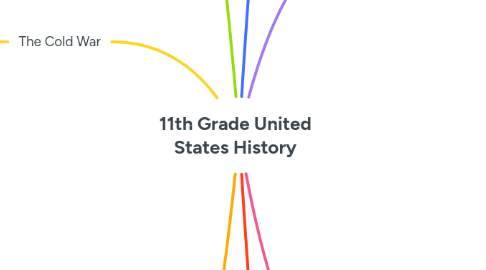
1. World War II
1.1. Causes for Joining the War
1.1.1. Students will create a timeline on the various events and policies that led up to the Second World War. They will organize the events based on the dates they took place and write a few sentences on why they were significant.
1.2. Japanese Internment Camps
1.2.1. Students will listen to a podcast interviewing a person who was forced to move into a Japanese Internment camp. Students will then write a response asking about what they thought was significant about the interview.
1.3. Treatment of Marginalized Communities
1.3.1. Students will be assigned a specific marginalized community (Black, Mexican, LGBT, etc) and will research how that specific group of people was treated throughout the war and shortly after. They will then join a small group and discuss what the learned from their research.
2. The Cold War
2.1. The Red Scare
2.1.1. Students will be assigned an excerpt of one of many people questioned by HUAC. They will write a short response on what the individual was questioned for and how they responded.
2.2. The Vietnam War
2.2.1. Students will listen to various music created by artists during the Vietnam War, some will be against the war while others support it. Students would analyze the songs and write down what message each song tried to carry.
2.3. Kennedy's Administration
2.3.1. Students will be assigned an event that took place in Kennedy’s presidency (Bay of Pigs, Cuban Missile Crisis, Berlin Wall) and create a short comic depicting the event. Each panel should have a text box describing the image.
3. Civil Rights Movement
3.1. MLK and Non-Violent Protests
3.1.1. Students will work in small groups and create a slideshow on one of the many protests conducted by black organizations and individuals. Students will then do a virtual tour looking into other groups’ presentations and write down the significance of each protest.
3.2. Malcolm X and Black Power
3.2.1. Students will be given a short speech given by various Black Power figures (Huey Newton, Malcolm X, Muhammad Ali, Audre Lorde, etc). They will listen and analyze what these figures were saying. They would then go into small groups and discuss what Black Power is and how these figures used it to combat racism in America.
3.3. Cesar Chavez and Mexican Labor
3.3.1. Students will read various newspaper articles about Cesar Chavez and his movement for Mexican Labor Rights. Students will write down the significance Cesar Chavez is and identify any bias those sources might have for the historical figure and the movement.
3.4. Feminism in the Sixties and Seventies
3.5. LGBT Rights
4. Early America
4.1. Enlightenment
4.1.1. Students will be divided into groups of four and be assigned a philosopher from the enlightenment period. They will read an assigned article about the philosopher and answer questions based on what they learned. Students then present what they learn to the rest of the class.
4.2. Revolutionary War
4.2.1. Students will create a timeline on the various battles that took place in the Revolutionary War. They will organize the battles based on the dates they took place and write a few sentences on why they were significant.
4.3. American Chattel Slavery
4.3.1. Students will read personal accounts from African-Americans about their experiences on Slavery. They will be assigned different articles that tell different accounts, Students would write down and discuss with their classmates the many mistreatments people endured under slavery.
4.4. Build-Up to Civil War
5. Civil War & Reconstruction
5.1. Causes of Civil War
5.1.1. Students would individually be given short articles describing the various arguments for the cause of the civil war. Students would then break into small groups and perform a small debate on whether the Civil War was caused solely on slavery or not.
5.2. Early Foreign Policy
5.2.1. Students would create a mind map on America’s foreign policy from the creation of the nation to the First World War. They would research various conflicts and policies including the War of 1812, Isolationism, Open Door Policy, etc.
5.3. American Racial Policy
5.3.1. Students would read/listen to personal accounts from marginalized communities (of the time) and learn about the way people of different races and ethnicities were treated differently from others.
5.4. Mass Emigration
6. World War I
6.1. Causes for Joining the War
6.1.1. Students will create images depicting the various causes for joining the First World War. They will also include short captions explaining the picture and how it relates to the cause.
6.2. The War Effort
6.2.1. Students will create a presentation on the various aspects of the First World War from domestic policy to strategies used by the United States.
6.3. Wilson's Promises
6.3.1. Students will read/listen to the many promises Wilson made about the First World War, including his promise of the League of Nations and the “War to End All Wars”. Students would then investigate the the broken promises made after the war ended.
7. The Roaring Twenties and The Great Depression
7.1. The Roaring Twenties
7.2. Causes of the Depression
7.2.1. Students will analyze a select few of images taken during the Great Depression. They will answer a set of questions about the image they are analyzing.
7.3. The Great Depression
7.3.1. One of President Hoover’s biggest mistakes was his faith in Laissez Faire economics. He believed that if over time the economy would’ve fixed itself, but the people got tired of waiting and voted for FDR the following election. Students would debate whether or not this economic theory would’ve worked if the American people waited longer and if it would’ve made the economy stronger or weaker.
7.4. FDR and New Deal Economics
7.4.1. Students would create images depicting the various programs and policies that were implemented as a part of FDR’s New Deal. They will provide captions to their images describing what the image depicts.
